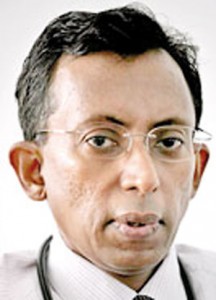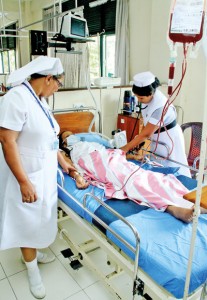News
Dengue crisis: Prevention and control too little, too late

Dr. LakKumar Fernando
Dengue numbers have sky-rocketed reaching a shockingly high nearly 50,000 cases, dealing death to more than 80 including a young mother who had just given birth to a baby.
This year’s dengue case-load has surpassed figures of all time.
“Lots of problems in dengue prevention,” is the verdict of dengue expert, Dr. LakKumar Fernando, a view echoed by numerous others.
This state of affairs, the Sunday Times understands, will get exacerbated with the resignation of the Chief Epidemiologist Dr. Paba Palihawadana who heads the Epidemiology Unit of the Health Ministry, with strong speculation that her post, which is a technical one, would be filled by an administrator without any technical knowledge in public health.
When asked, Dr. Fernando said that he had no confirmation of such an appointment, but if that is done it would tantamount to adding insult to injury in the case of dengue prevention.
There just isn’t a precise and rapid system of coordination in the prevention of dengue, stresses Dr. Fernando, who established the Centre for Clinical Management of Dengue (DF) and Dengue Haemorrhagic Fever (DHF) at the Negombo Hospital, which provides treatment for both children and adults from many parts of Sri Lanka.
Currently the Consultant Paediatrician of the Gampaha General Hospital, he is a honorary Visiting Consultant at Negombo’s Dengue Centre and heads the Sri Lanka College of Paediatricians. He was also a co-author of the Guidelines for Prevention and Control of Dengue of the World Health Organization (WHO) and the main author of Sri Lanka’s Guidelines on Clinical Management of DF/DHF.
“On paper there is coordination in prevention and control activities, but there is ‘a problem with the timing’. Is it fast enough and is the follow-up adequate,” asks Dr. Fernando laying down the essentials for dengue prevention as:
*A very proactive surveillance system throughout the year and not just when a massive dengue epidemic breaks out. It is vital to kill off an epidemic before it hits the people.
*Whenever any clinician, in the private or state sectors, wherever in the country suspects that his/her patient is having dengue, there is an immediate need to notify the relevant authorities – not a day, three days or a week later.
* This should be followed by a rapid response, with teams in the relevant areas rushing to the spot from which the patient has come, to check out mosquito breeding sites and adult mosquitoes and conduct effective mopping up operations to prevent more people being affected.
While it is commendable that the authorities are attempting to mop-up whole towns and cities in their battle against dengue, if there is immediate and focused mopping-up, targeting the areas from which patient-clusters are emerging, there will be significant triumphs over dengue.
Mopping-up is happening, but there seems to be slight delays in the response and by that time the infected mosquitoes have moved onto other areas. As a clinician, Dr. Fernando has seen patient clusters coming in a continuous stream from an affected area.

A dengue patient being attended to. File pic
*The final aspect of such a dengue prevention programme would be heavy public awareness. This should be two-pronged. The need for the public to be vigilant with regard to mosquito-breeding spots in and around their homes, workplaces, construction sites, schools, tuition classes etc., and destroying them throughout the year. The other is making sure that men, women and children would seek early treatment from a hospital when suspected of having dengue.
“We need a 24-hour hotline for clinicians to be able to inform the relevant authorities immediately about the suspected dengue cases they are seeing. The response by the authorities should be immediate in launching effective mopping-up operations in the battle against dengue-dealing mosquitoes as well as their larvae,” says Dr. Fernando, reiterating that the rapid-response should be carried out instantly, with military-like precision.
Otherwise, he laments, by the time the wheels of bureaucracy begin turning and the teams go to the area from which a suspected dengue patient or patients have emerged, the infected mosquitoes have moved on, to a different area, leaving a trail of disease.
Next would follow the urgent need to identify whether a suspected dengue patient, is actually having dengue as there are many viral fevers doing the rounds. “We need to identify the dengue patients from the non-dengue patients as fast as possible, as otherwise the resources and personnel in hospitals looking after dengue patients, with a ‘flood’ as of now, would be stretched to the limit,” says this clinician.
Pointing out that his suggestion that the Rapid Dengue Antigen Test should be done to pick out the dengue patients as opposed to the non-dengue patients on Day1 has not received favour with the authorities, Dr. Fernando states his case.
It certainly should not be done on someone who has just had a fever for a little while, but on those who have had at least two episodes of fever or more, he says arguing that if anyone has had fever above 100 F0 (37.7 C0), for 12 to 24 hours, the Rapid Dengue Antigen Test will indicate to the doctors whether it is dengue or not. Usually, a person’s body temperature is 98.6 F0 (37 C0).
Dr. Fernando is a firm believer that the Rapid Dengue Antigen Test helps to differentiate quickly between dengue and non-dengue viral flu. If the test is carried out with the proper kit, it is “almost possible” to exclude dengue.
According to him, the sensitivity of the Rapid Dengue Antigen Test is:
If done between 12-24 hours (Day 1) of the onset of more than 100 F – almost 100% sensitivity
Day 2 – 90% sensitivity
Day 3 – sensitivity can fall as low as 70%
Day 4 – sensitivity is less than 50%
| Is rapid onset of platelet drop and fluid leakage due to DEN-2? The large numbers and the severity of the current dengue epidemic raging in the country may be due to the circulation of the DEN-2 type, as opposed to the earlier types, says Dr. LakKumar Fernando, hastening however to add that it is too early to confirm yet. There are four dengue virus types or strains – DEN-1, DEN-2, DEN-3 and DEN-4. He stresses that in this dengue epidemic, the reduction in the platelet count of the patient and the onset of fluid leakage seem to be more rapid and starting earlier than in the disease caused by the other three virus types. This is why it is crucial to do a full-blood count as the platelet drop and fluid leakage occur on Day 2 and 3, unlike in the other three types, when they come later by about Day 4. The pattern which Dr. Fernando suspects is happening with DEN-2 and seems quicker is: The platelet count dropping from Day 2, whereas with the other types it occurs on Day 3 The fluid leakage beginning on Day 3, whereas with the other types it usually occurs on Day 4 As to why he suspects that the virulence of this epidemic is high, he says that it could be due to “many factors”. It could be because a large proportion of the population has had a primary (earlier) infection with another type, as dengue is now endemic in the country. “With a second infection, the patient would be hit harder.” Why do patients die, even if they come to hospital on time? “It could be due to a drop in the strict monitoring schedule of those with Dengue Haemorrhagic Fever, if there are no other serious issues with the patient and the patient has sought treatment on time. The monitoring may slag a little due to the staff being weary and tired out because of the heavy workload from attending to the non-ending stream of patients.
|
| Differentiation of ‘twins’ and monitoring key to saving lives There are four strains or types of dengue – DEN-1, DEN-2, DEN-3 and DEN-4. Any one of these strains can cause either Dengue Fever (DF) or Dengue Haemorrhagic Fever (DHF). Infection with one strain provides immunity only to that strain, the Sunday Times learns, while if a person gets another strain, the antibodies created in the body by the first infection will make the second more severe. The key to saving lives lies in distinguishing between the “twins” of DF and DHF as they look very similar in the first two days of illness. The four essential criteria in the clinical definition of DHF, according to Dr. LakKumar Fernando are: Fever or recent history of acute fever Haemorrhagic manifestations Low platelet count – 100,000/mm3 or less Objective evidence of leaky capillaries – elevated haematocrit, low albumin/cholesterol and pleural or other effusions The main pointer to whether it is DF or the ‘dangerous’ form of DHF is whether there is plasma leakage or not, it is learnt. There is NO plasma leakage in DF, Dr. LakKumar Fernando is categorical, reiterating that DF will never end in DHF. A major danger signal of DHF is plasma leakage from the blood vessels to body cavities such as the abdominal cavity and the pleural cavity. ‘Objective’ evidence of leaky capillaries should give the red-alert to the doctors that it is DHF, as there is no plasma leakage in DF. A drop in the platelet count, meanwhile, will direct the doctor towards the diagnosis that the patient may be suffering from dengue, but the essential haematocrit count and ultrasound or X-ray evidence of fluid in the chest (pleural cavity) or abdomen (peritoneal cavity), will be evidence of DHF. Tests such as serum albumin and cholesterol level can also help when it is difficult to determine whether it is DF or DHF. DHF has three important and distinct phases and that is why it is crucial for dengue patients to be monitored very closely, he says, adding that it should not be two-hourly but half-hourly with detailed charts being kept. The Paediatrician or the Physician needs to be accessible to their juniors and be alerted immediately if there is a change. As many patients appear conscious and very alert until the last stage of shock, health personnel may have a misconception that they are doing well. To see the early signs of shock, pulse and blood pressure need to be measured frequently. Shock comes in different forms — the patient may become restless briefly before going into shock and becoming pulseless, needing quick action to resuscitate him/her. Whenever pulse, blood pressure or urine output drops or haematocrit increases, the rate of infusion may have to be increased but once they stabilize the rate should be reduced, preventing a fluid overload.
|
| Examine your surroundings often to ward off dengue The dengue-spreading Aedes aegypti and Aedes albopictus are tiny with white dots on their legs. They are more likely to bite in the morning — between 6 and 10 a.m. — and early afternoon-evening — between 3 and 6 p.m. They are ‘container-breeders’ which means that they can lay eggs in anything even with a few drops of clean water such as yoghurt cups, a half-peel of rambutan, a rigi-foam box, polythene wrappers, flower vases, birth-baths, ornamental pots in the garden, gutters, potted plants, discarded thambili, tyres holding down roofs, the water-collecting tray of the fridge, the little containers of water, to ward off ants that sweets may be stored on, even a large leaf which may have a few drops of water, uneven cemented areas at building sites and much more. |

